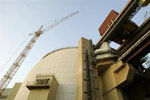 Reuters: Iran is conducting final tests at its first nuclear power plant and it is expected to start generating electricity in the next two months, Iranian media said on Monday.
Reuters: Iran is conducting final tests at its first nuclear power plant and it is expected to start generating electricity in the next two months, Iranian media said on Monday.
 TEHRAN (Reuters) – Iran is conducting final tests at its first nuclear power plant and it is expected to start generating electricity in the next two months, Iranian media said on Monday.
TEHRAN (Reuters) – Iran is conducting final tests at its first nuclear power plant and it is expected to start generating electricity in the next two months, Iranian media said on Monday.
Meant to be the first of a network of nuclear power stations Iran says it is planning, the Russian-built Bushehr complex has missed deadline after deadline to come on stream, most recently fuel had to be removed and checked for technical problems.
Fars news agency said Bushehr would start injecting power into the national electricity grid in the next two months.
“Right now, after the fuel rods that were unloaded from the reactor core were washed, they are being loaded again and final tests are under way,” Gholamali Miglinejad, a member of a parliamentary committee monitoring Bushehr, was quoted as saying by the student news agency ISNA.
Iran began loading fuel into Bushehr last August in front of foreign and domestic media, touting it as a symbol of resistance to international sanctions imposed by countries that suspect the Islamic state is seeking nuclear weapons, something it denies.
At that time, Iranian officials said it would take two to three months for Bushehr to start producing power, and that it would generate 1,000 megawatts, about 2.5 percent of Iran’s electricity usage. Russia is providing the fuel for Bushehr.
But the start-up of the plant has been hit by several delays since then, with some analysts blaming the mysterious Stuxnet computer virus. Tehran said Stuxnet had afflicted staff computers at Bushehr but not affected major systems there.
Security experts say the computer worm may have been a state-sponsored attack on Iran’s nuclear program and have originated in the United States or Israel. Neither country has mentioned any link with Stuxnet.
Diplomats and security sources say Western governments and Israel view sabotage as one way of slowing Iran’s nuclear work.
NUCLEAR SABOTAGE IN IRAN?
Some analysts believe Iran may be suffering wider sabotage aimed at slowing its nuclear advances, pointing to a series of unexplained technical glitches that have cut the number of working centrifuges at its Natanz uranium enrichment plant.
Natanz is at the core of Western concerns about Iran’s nuclear intentions since the country, without any nuclear power plants other than Bushehr, has no current civilian use for enriched uranium. Western leaders believe Iran, one of the world’s biggest oil and gas producers, secretly aims to refine uranium to the high degree suitable for atom bombs.
Earlier this month, an Iranian official said his country had been hit by a new malware called “Stars.” But foreign experts have voiced doubt that this represented a second cyber attack.
The Bushehr plant was begun by German electronics giant Siemens in the 1970s but the project was halted by Iran’s Islamic Revolution in 1979.
Russia later completed the plant and will supply its fuel.
To ease concerns abroad that Iran might reprocess spent fuel rods from Bushehr into bomb-grade plutonium, Russia will repatriate the used fuel. The plant will also be regularly monitored by inspectors of the U.N. nuclear watchdog agency.
Western officials have urged Iran to join the 1996 Convention on Nuclear Safety, saying the Islamic state would be the only country operating a nuclear reactor which is not part of the international pact once Bushehr is launched.
The convention, with 72 signatory states at present, was designed to boost global nuclear safety, an issue that has gained more significance in light of Japan’s Fukushima nuclear crisis, through a system of peer review and mutual oversight.
“The plant’s location on the coast makes the safety of Iran’s nuclear program a regional security concern,” the International Institute for Strategic Studies, a think-tank, said in a report last month.
It noted that Bushehr, like Fukushima, is in an earthquake zone. But Iran does not need to fear a tsunami of the size that knocked out the electricity and back-up cooling systems at Fukushima, as Bushehr is located by the Gulf and not an ocean.
(Additional reporting by Fredrik Dahl in Vienna; writing by Ramin Mostafavi; editing by Mark Heinrich)


